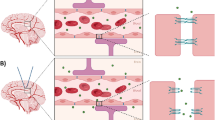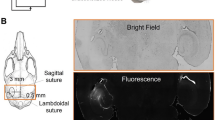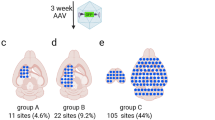Abstract
Transcranial ultrasound combined with intravenous microbubbles can be used to increase blood-brain barrier permeability or, at lower pressures, to mediate sonoselective gene delivery to endothelial cells. Previously, sonoselective gene delivery with plasmid-coated microbubbles as gene carriers resulted in transient transgene expression in the brain endothelium. We investigated the potential of recombinant adeno-associated virus 9 (rAAV9), a serotype known for its efficient transduction and long-term transgene expression, for sonoselective gene delivery to endothelial cells of the brain. We found that rAAV9 led to gene delivery to brain endothelial cells following intravenous administration at a dosage of 1 × 1011 GC/g. However, the sonoselective gene delivery approach with intravenous rAAV9, using the same parameters as previously used for plasmid delivery, did not increase transgene expression in brain endothelial cells targeted. These results suggest that intravenous rAAV9 are using mechanisms of entry into the cerebrovasculature that are not significantly influenced by sonoselective treatments known to facilitate endothelial cell entry of plasmids coated onto microbubbles.
This is a preview of subscription content, access via your institution
Access options
Subscribe to this journal
Receive 12 print issues and online access
$259.00 per year
only $21.58 per issue
Buy this article
- Purchase on Springer Link
- Instant access to full article PDF
Prices may be subject to local taxes which are calculated during checkout




Similar content being viewed by others
Data availability
Data is available from corresponding authors on reasonable request. Viral genome plasmids pEMS2143 and pEMS2181 are available to the research community through the nonprofit distributor Addgene (Cambridge, MA) (www.addgene.org).
References
Mendell JR, Al-Zaidy S, Shell R, Arnold WD, Rodino-Klapac LR, Prior TW, et al. Single-dose gene-replacement therapy for spinal muscular atrophy. N Engl J Med. 2017;377:1713–22.
Castle MJ, Baltanás FC, Kovacs I, Nagahara AH, Barba D, Tuszynski MH. Postmortem analysis in a clinical trial of AAV2-NGF gene therapy for alzheimer’s disease identifies a need for improved vector delivery. Hum Gene Ther. 2020;31:415–22.
Nakamura S, Osaka H, Muramatsu S, Takino N, Ito M, Jimbo EF, et al. Intra-cisterna magna delivery of an AAV vector with the GLUT1 promoter in a pig recapitulates the physiological expression of SLC2A1. Gene Ther. 2021;28:329–38.
Philippidis A. Fourth boy dies in clinical trial of Astellas’ AT132. Hum Gene Ther. 2021;32:1008–10.
Thévenot E, Jordão JF, O’Reilly MA, Markham K, Weng Y-Q, Foust KD, et al. Targeted delivery of self-complementary adeno-associated virus to the brain, using MRI-guided focused ultrasound. Hum Gene Ther. 2012;23:1–12.
Kofoed RH, Noseworthy K, Wu K, Sivadas S, Stanek L, Elmer B, et al. The engineered AAV2-HBKO promotes non-invasive gene delivery to large brain regions beyond ultrasound-targeted sites. Mol Ther Methods Clin Dev. 2022;27:167–84.
Gorick CM, Mathew AS, Garrison WJ, Andrew Thim E, Fisher DG, Copeland CA, et al. Sonoselective transfection of cerebral vasculature without blood-brain barrier disruption. Proc Natl Acad Sci USA. 2020;117:5644–54.
Korecki AJ, Cueva-vargas JL, Fornes O, Agostinone J, Farkas RA, Hickmott JW, et al. Human MiniPromoters for ocular-rAAV expression in ON bipolar, cone, corneal, endothelial, Müller glial, and PAX6 cells. Gene Ther. 2021;28:351–72.
de Leeuw CN, Dyka FM, Boye SL, Laprise S, Zhou M, Chou AY, et al. Targeted CNS delivery using human MiniPromoters and demonstrated compatibility with adeno-associated viral vectors. Mol Ther - Methods Clin Dev. 2014;1:1–15.
Kofoed RH, Heinen S, Silburt J, Dubey S, Dibia CL, Maes M, et al. Transgene distribution and immune response after ultrasound delivery of rAAV9 and PHP.B to the brain in a mouse model of amyloidosis. Mol Ther - Methods Clin Dev. 2021;23:390–405.
Kofoed RH, Dibia CL, Noseworthy K, Xhima K, Vacaresse N, Hynynen K, et al. Efficacy of gene delivery to the brain using AAV and ultrasound depends on serotypes and brain areas. J Control Rel. 2022;351:667–80.
Weber-Adrian D, Kofoed RH, Silburt J, Noroozian Z, Shah K, Burgess A, et al. Systemic AAV6-synapsin-GFP administration results in lower liver biodistribution, compared to AAV1&2 and AAV9, with neuronal expression following ultrasound-mediated brain delivery. Sci Rep. 2021;11:1–13.
Thévenot E, Jordão JF, O’Reilly MA, Markham K, Weng Y-Q, Foust KD, et al. Targeted delivery of self-complementary adeno-associated virus Serotype 9 to the brain, using magnetic resonance imaging-guided focused ultrasound. Hum Gene Ther. 2012;23:1144–55.
Trinh D, Nash J, Goertz D, Hynynen K, Bulner S, Iqbal U, et al. Microbubble drug conjugate and focused ultrasound blood-brain barrier delivery of AAV-2 SIRT-3. Drug Deliv. 2022;29:1176–83.
Geers B, Lentacker I, Alonso A, Sanders NN, Demeester J, Meairs S, et al. Elucidating the mechanisms behind sonoporation with adeno-associated virus-loaded microbubbles. Mol Pharm. 2011;8:2244–51.
Hosseinkhah N, Goertz DE, Hynynen K. Microbubbles and blood-brain barrier opening: a numerical study on acoustic emissions and wall stress predictions. IEEE Trans Biomed Eng. 2015;62:1293–304.
Sheikov N, McDannold N, Vykhodtseva N, Jolesz F, Hynynen K. Cellular mechanisms of the blood-brain barrier opening induced by ultrasound in presence of microbubbles. Ultrasound Med Biol. 2004;30:979–89.
Sheikov N, McDannold N, Jolesz F, Zhang YZ, Tam K, Hynynen K. Brain arterioles show more active vesicular transport of blood-borne tracer molecules than capillaries and venules after focused ultrasound-evoked opening of the blood-brain barrier. Ultrasound Med Biol. 2006;32:1399–409.
Sheikov N, McDannold N, Sharma S, Hynynen K. Effect of focused ultrasound applied with an ultrasound contrast agent on the tight junctional integrity of the brain microvascular endothelium. Ultrasound Med Biol. 2008;34:1093–104.
Acknowledgements
The authors thank Kristina Mikloska and Shawna Rideout for their invaluable contributions during focused ultrasound treatments. For imaging we are grateful to Microscopy and Imaging Laboratory (MIL) at the University of Toronto and Centre for Flow Cytometry and Microscopy at Sunnybrook Research Institute. We thank Dr. Yutaka Amemiya at the Genomics Core Facility, Sunnybrook Research Institute, for droplet digital PCR analysis. Salary support was provided by Carlsberg Internationalisation Fellowship (#CF20-0379 to RHK) and Canada Research Chairs Program (CRC Tier 1 in Brain Repair and Regeneration to IA). This research was supported by Canadian Institute of Health Research (to IA: 137064, 166184, and 168906; and to KH: 154272), the National Institute of Biomedical Imaging and Bioengineering of the National Institutes of Health (KH: RO1-EB003268), the Temerty Chair in Focused Ultrasound Research (KH), and FDC Foundation, the WB Family Foundation, Gerald and Carla Connor. EMS received funding from the Weston Brain Institute (TR160014).
Author information
Authors and Affiliations
Contributions
RHK, IA, and KH designed the study. EMS designed and supplied rAAV vectors. RHK performed experiments, tissue processing, data analysis, and created figures and manuscript drafts. All authors edited and proofread the manuscript.
Corresponding authors
Ethics declarations
Competing interests
RHK, KH, and IA declare no competing interest. EMS holds issued patents on CLDN5 MiniPromoters.
Additional information
Publisher’s note Springer Nature remains neutral with regard to jurisdictional claims in published maps and institutional affiliations.
Rights and permissions
Springer Nature or its licensor (e.g. a society or other partner) holds exclusive rights to this article under a publishing agreement with the author(s) or other rightsholder(s); author self-archiving of the accepted manuscript version of this article is solely governed by the terms of such publishing agreement and applicable law.
About this article
Cite this article
Kofoed, R.H., Simpson, E.M., Hynynen, K. et al. Sonoselective delivery using ultrasound and microbubbles combined with intravenous rAAV9 CLDN5-GFP does not increase endothelial gene expression. Gene Ther 30, 807–811 (2023). https://doi.org/10.1038/s41434-023-00389-y
Received:
Revised:
Accepted:
Published:
Issue Date:
DOI: https://doi.org/10.1038/s41434-023-00389-y



